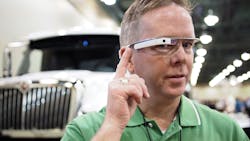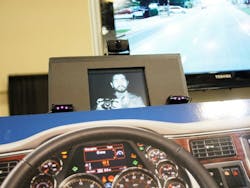Augmented reality may help drivers one day give up the wheel
It's hard not to move your leg as if to step on the brake pedal or want to grab the steering wheel now and then when you're in a self-driving vehicle in the current state of experimentation with the technology. That's where augmented reality (AR) — promising since the heyday of Google Glass and now taking various different forms — may be the bridge that helps drivers accept autonomous vehicles, a global consultancy predicts.
ABI Research has some big expectations for AR technology, including that it "will redefine the driving and ownership experience" of vehicles by giving drivers helpful information like highlighting pedestrians or obstacles in the roadway. In time, drivers will come to appreciate and trust the assistance, helping set the stage for vehicles that'll drive themselves. That's the theory at least, but the key variable for AR going forward is how it's delivered.
Unlike virtual reality, which shows and lets the user interact with a fully artificial, computer-generated "world," AR tech gives the user a layered image or supplemental information on top of actual reality. It's typically provided via smart glasses or head-up displays, or HUDs, and that latter form is how ABI expects augmented reality will catch fire.
"I do think augmented reality is going to be big" in vehicles, Dominique Bonte, ABI's managing director and vice president for B2B, told Fleet Owner. With HUDs, "there are several ways to do it," he added. "Either it's a glass plate on top of your dashboard where you can display navigation and other types of instructions, or it's a laser type of technology that displays information directly on the windscreen.
"But it's still only on a small area," Bonte continued. "Maybe further down the road, we could imagine that the entire windscreen would be used to display information like obstacle detections and other things." The crucial differentiator with AR technology, which has yet to go fully mainstream in vehicles, is this: whether it uses a fixed or wearable/ mobile display.
Why not smart glasses?
You may not think of it as AR technology, but that's what that world-record line you've been watching Olympic swimmers chase or onscreen first-down marker NFL players reach for is. Another of the most recent and well-known examples of AR is Pokemon GO, Niantic's free game launched last month that brings the technology prominently into the smartphone space as well; the game lets you find and interact with fictional Pokemon animated creatures that are displayed on the phone as if they were actually there.
If you're familiar with Pokemon GO, you've likely also heard about controversy the game quickly stirred up, with some claiming it's a public nuisance and essentially just another thing people are glued to instead of the real world around them, leading to accidents (think "distracted walking"). That same sentiment has kept smart glasses largely out of the vehicle space, even though there have been a number of potentially useful safety, navigation and other applications developed for them.
"The big fear was that people would use [smart glasses] to do unsafe things while driving — think about watching movies or checking Facebook," Bonte said. "That resulted in multiple countries actually banning Google Glass for such uses, for example, before the technology was even commercially available."
But don't count wearable AR tech fully out for vehicles yet: after all, Google Glass was "just phase one" of AR smart glasses, noted Wes Mays, director of product innovation at fleet management solutions company Omnitracs. Earlier this year — which is long after the Google Glass product was de facto discontinued in 2014 — Omnitracs used a pair to demonstrate an anti-distraction program for trucking. Similar to facial recognition commonly seen in consumer cameras and smartphones, the program could identify speed, stop and yield signs and provide alerts and warnings for the driver if necessary, and could be expanded easily for more uses.
"A large vehicle would need to know that the curve ahead is rated for only 25 mph, for example, and the glasses could warn the driver to slow down if he needs to," Mays told Fleet Owner. "Another big one might be temporary work zones that aren't on a map or in a database. We can see the sign; we can read the sign; we can warn the driver. We're really excited about a lot of the camera-based technologies."
Will AR technology become common in vehicles in some form? "Absolutely," contended Mays, adding, however, "I'm just not sure it's going to be any sort of wearable." Things like smart glasses are more likely to be used by truck technicians, he suggested, who you'll already find going back and forth to laptops in much of their work on today's computer-run trucks.
Truck drivers, on the other hand, who frequently spend nine or 10 hours at a time at their job, probably won't take to smart glasses at least for driving because "it's just something else you'd have to have on that whole time," Mays said.
A boom (and irony) in AR HUDs
ABI Research predicts that by 2025, some 15 million AR HUDs for vehicles will ship, with 11 million of those being embedded systems. The firm notes that automotive OEMs testing and exploring the use of HUDs include Faraday Future, Ford, Hyundai and others; you can buy BMW, Chevrolet, Lexus, Mercedes-Benz, Ford and Volvo passenger cars with AR HUDs today, to name several, but it's still more a niche or high-end option.
Even so, "it's just a matter of time before these migrate over to commercial vehicles as well," Omnitracs' Mays surmised.
Ironically, the main reason smart glasses stalled in vehicle use — their potential for distraction — is precisely what some say AR HUDs could eliminate and help the technology take off in the same space. And we're talking not only Information Age distraction but the kind going back to the start of automobiles. CNET's Brian Cooley, for one, contends that traditional automotive gauges and instruments themselves actually are a distraction forcing drivers to look away from the road and don't make much logical sense.
A speedometer is in your vehicle's dash somewhere, for example, likely in front of the steering wheel, but with a HUD could be projected unobtrusively in the driver's view or perhaps next to speed limit signs. Cooley also points out that a temperature gauge is in the dash, but why not overlay a color as needed or on demand — say, icy blue or bright red — where the driver sees the hood? If using GPS navigation, why not display an arrow over the roadway ahead to show the driver where to turn?
The potential applications clearly are there, and AR technology has been filtering into the mainstream in various ways for some time. There are still hurdles, though, for AR HUDs to make a true breakthough in vehicles, according to ABI Research, and it boils down to a very similar situation to that of autonomous vehicles — things like better accuracy and "no matter what" reliability.
"These [technological challenges] include how to capture and interpret road geometry through computing-intensive sensor function, precise vehicle positioning, laser projection, driver monitoring via inward-facing cameras, and designing sophisticated algorithms to generate precise augmentation content in the viewing field of the driver," ABI's Bonte stated.
About the Author
Aaron Marsh
Aaron Marsh is a former senior editor of FleetOwner, who wrote for the publication from 2015 to 2019.

